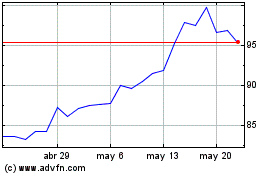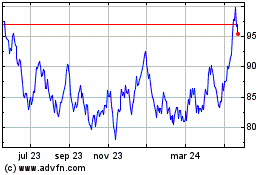Strong Auto Sales: Good News for Metal ETFs? - ETF News And Commentary
16 Enero 2013 - 8:04AM
Zacks
Auto sales are finally getting back on track after suffering a
major setback during the recession of 2008. The Big Three Detroit
automakers, who command a huge share of the U.S. auto market, have
bounced back with the help of a gradual recovery in the global
market, restructuring of their product portfolios, strong pent-up
demand and cheap financing.
Besides, higher average age of cars on U.S. roads (more than 10
years) and an improving unemployment rate have been the key factors
in driving auto sales in the U.S. despite the rising gasoline
prices. In fact, in November 2012, U.S. auto sales reached its
five-year high by registering 15% growth to 1.14 million sales in
vehicles. The good news came on the heels of a Sandy-wrecked
October suggesting that a long-awaited optimistic outlook may
finally be here.
With the recent uptick in Auto sales, some allied sectors,
especially metals like palladium and platinum should also be in
high demand (see Why You Don't Need Both the Palladium and Platinum
ETFs). It would thus be prudent for investors to tilt their
portfolios towards these sectors.
Automotive Recovery to Benefit Price of Palladium and
Platinum
The Automotive industry always acts as a catalyst for the
increase in prices of palladium and platinum. These metals find use
in vehicle exhaust catalytic converters to manage vehicle
emissions.
Thanks to the regulation on emission from diesel engines in
Europe, U.S. and Asia along with increased demand for vehicles,
ETFs like ETFS Physical Palladium Shares (PALL)
and ETFS Physical Platinum Shares (PPLT) should
stand to benefit from an eventual ramp up in pricing in 2013.
Both the funds are traded in the form of shares and are designed
to reflect the prices of the respective metals, plus accumulated
interest, less the Trust’s expenses. The two metals are securely
stored in London and Zürich on behalf of the custodian, JP Morgan
Chase Bank and both PPLT and PALL currently carry a Zacks Rank #2
(Buy).
Let’s take a closer look of some of the key fundamentals for
both of these ETFs below and how they stack up in the broader fund
market:
ETFS Physical Platinum Shares (PPLT)
Launched in August 2010, this passively managed exchange traded
fund seeks to replicate the performance of the spot price of
platinum (See Platinum ETF Investing 101).
The ETF has more than $8.0 billion in assets and trades in
volumes of around 68,465 daily. PPLT is a low-cost choice not only
in the platinum family of ETFs but also costs less than holding
physical platinum thanks to a tight bid ask spread. The product
charges a ratio of 60 basis points.
ETFS Physical Palladium Shares (PALL)
Launched in August 2010, PALL seeks to gain exposure in
palladium (See Zacks #1 Ranked Precious Metal ETF: PALL). The ETF
amassed more than $4.7 billion in assets and trades in decent
volumes, roughly 70,000, on average. Like PPLT, this ETF also
charges a modest expense ratio of 60 basis points.
The Bottom Line
Both the products are paying off quite handsomely. While in the
last one-year period, PALL’s return of 10.71% has outperformed PPLT
(2.30%) by about 840 basis points, we are seeing a reversal in
trend since the beginning of the New Year.
In the YTD period, palladium returned around 4.13% while
platinum delivered 14.24%. Probably, this is due to supply concerns
for platinum in key markets like South Africa.
The recent South African mining strikes will keep its supply
range bound as it is a scarce metal. Apart from an easy
year-over-year comparison, the supply crunch could be another
reason for the fund’s recent rally.
On the other hand, while being far more volatile than its
platinum counterpart, palladium is more responsive to the rebound
in the automotive sector. Manufactures sometimes substitute the
requirement of higher-priced platinum with this lower-priced metal.
Again, palladium’s advanced durable nature also makes it a better
alternative for some aspects of the automotive process.
Prices of metals like palladium and platinum were hard hit
during the economic recession owing to muted industrial activity.
Both PALL and PPLT are currently trading below their respective
52-week highs.
Yet, we may take advantage of their undervalued situation and
invest in these metal ETFs, particularly at a time when the auto
sector is revving up and supply concerns suggest a bullish trend
for 2013.
Want the latest recommendations from Zacks Investment Research?
Today, you can download 7 Best Stocks for the Next 30
Days. Click to get this free report >>
ETFS-PALLADIUM (PALL): ETF Research Reports
ETFS-PLATINUM (PPLT): ETF Research Reports
To read this article on Zacks.com click here.
Zacks Investment Research
Want the latest recommendations from Zacks Investment Research?
Today, you can download 7 Best Stocks for the Next 30 Days. Click
to get this free report
Abrdn Palladium ETF (AMEX:PPLT)
Gráfica de Acción Histórica
De May 2024 a Jun 2024

Abrdn Palladium ETF (AMEX:PPLT)
Gráfica de Acción Histórica
De Jun 2023 a Jun 2024
